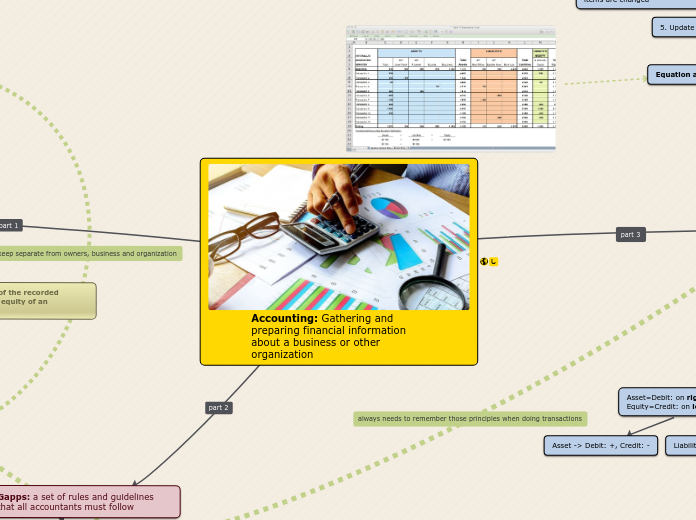arabera Ellie Qian 4 years ago
1567
Copy of the Accounting G11: Chapter 1 Concept Map

arabera Ellie Qian 4 years ago
1567

Honelako gehiago
A/R and Bank(cash)
A/P and Bank(cash)
A/R and Capital
Assets and A/P
5. Update the balance sheet
4. Make sure each transaction has two individual items are changed
3. Start record each transaction
2. Record the initial balances from its corresponding balance sheet.
1. Write down the fundamental accounting equation and list the items in the assets, liabilities, and owner’s equity sections
Ex: Invoice, Telephone bill, cheque copies, store receipts
Exeptional Balance (an account ends up with a balance opposite to its normal one)
Ex: overpay an account payable; Customer overpays account balance, etc
Account Balance
First record all the transactions on T-account, then subtract the smaller total from the larger total. Write the result under the larger of the two pin totals.
Dollar value of an account and shows whether it is a debit or a credit
Steps(Assets on left; Liabilites & OE on right in the beginning)
3. Record the transactions
2. Record the initial amount for each account
1. Write the names of accounts
Liability/Owner's Equity -> Debit: -, Credit: +
Asset -> Debit: +, Credit: -
Total debit entry=Total credit entry
First entry debit, second is credit
Owner's Equity: The difference between our assets and our liabilities
Liabilities: Things the company owes
Ex: Acounts Payable, Bank Loan, Mortgage
Assets: Resources (things) owned by a business
Ex: Cash, Accounts Receivable, Supplies, Equipment, etc
Due day: list what you need to pay first at first
Order by useful life
Order of Liquidity
Assumes that the business will continue to operate unless it is known that it will not
Accounting for a business should be fair and reasonable
Ex: You can't say your business worth 1,000,000,000 dollars when you just get started because that's impossible.
Revenue must be recorded when the transaction was complete
Consistent time periods
The global standard time periods are monthly, quarterly and yearly.
All information needed for a full understanding of a company’s financial statements must be included with the financial statements
Once you adopt an accounting principle or method, continue to follow it consistently
Each expense item related to revenue earned must be recorded in the same accounting period as the revenue it helped to earn
Ex: If a bought a thing in 2019 but no one use it until one year later someone use it to make money/do things, then the expense should be recorded 2020.
Provide objective evidence
Ex: You can not say this dessert is the most delicious one in the world because that's probably not correct.
Record the value as the purchase price.
Ex: If your company used $30 to buy an item, but one day later, it changed to $40, you need to record the money as $30 as this is how much you pay to buy it.
Keep separate from the personal affairs of owner, other business or organization
Ex: Business owner can use money for personal things
Highly regulated by provincial and federal government
Ex: Business names that include Inc (Incorporated), Corp(corporation) or Ltd(limited)
Business that owned by two or more partners, share responsibilities and costs
Ex: McPearson & Scott Charterd Accountants
Business that owned by a single person
Ex: Dr.Joe Dimitry; Dentist
Businesses that do not earn money
Ex: charities; amateur sports organization; curches, etc
Buy raw materials and manufacture goods
Ex: computer manufacturer; food-processing company,etc
Sell physical items (buy from a manufacturer)
Ex: clothing store; department store; grocery store, etc
Only sell services to customers, provide intangible things instead of physical and durable things. Provided by skilled people
Ex: accounting firm; catering company; cinema; teacher; doctor, etc